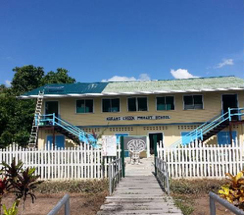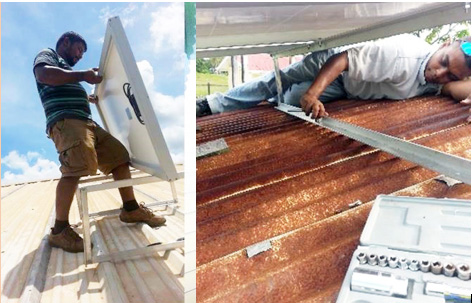Georgetown-November 2016: The Guyana Energy Agency (GEA), under a 2016 capital budgeted project, has completed the installation and rehabilitation of four (4) solar systems at schools located in the hinterland and riverain communities and who were without access to electricity.
The following schools were the beneficiaries:
58 Miles Primary School:
Located at 58 Miles Village along the Mabura Road in Region 10, the 58 Miles Primary School has a student population of 43 students. Facilitated by GEA’s engineers, Leon DeSouza and Kenny Samaroo, and technician Everard Rampersad, a solar photovoltaic system comprised of a 140 Watts solar panel, 10 Amps charge controller, a 200 Amp-Hour battery and a 600 Watts pure sinewave inverter was installed at the school. Two switch socket outlets, providing 120 VAC, and 4 X 10 watts LED lamps were installed at strategic locations at the school, with one of the lamps providing security lighting.
According to the Head Teacher, Miss Thompson, the school never had electricity and sessions would be interrupted on rainy days. The students were also put at a disadvantage since the Ministry of Education’s Interactive Radio Instruction (IRI) program could not be facilitated. The PV system installed by GEA is expected to produce 208 kWh of energy annually. The lamps are expected to consume 117 kWh of energy annually and the remaining energy will supply the IRI equipment and a laptop computer.
Abrams Creek Primary School
With a population of 57 students, Abrams Creek Primary School is located next to the Warapana River in Pomeroon-Supenaam, Region 2. The only access to the school is by river transport. The school experienced similar situations as 58 Miles Primary school. GEA’s Engineers, led by Mr. Leon DeSouza, installed a solar system comprising of a 140 Watts solar panel, 10 Amps charge controller, a 200 Amp-Hour battery and a 600 Watts pure sinewave inverter. Two switch socket outlets and 3 X 10 watts LED lamps were installed at strategic locations of the school.
The system is expected to produce 213 kWh of energy annually while the lamps are expected to consume 88 kWh of energy annually if operated for 8 hours per day for 365 days. The remaining energy will supply the IRI equipment, a television set and a laptop computer.
Dredge Creek Primary School
Also located in Pomeroon-Supenaam, Region 2, Dredge Creek Primary School has a population of approximately 90 students and never had electricity at the school. Access to the school is mainly by river transport but road transport is also possible during the dry seasons. The engineers installed a solar system which comprises of 2 X 140 Watts solar panels, 20 Amps charge controller, a 200 Amp-hour battery and a 600 Watts pure sinewave inverter. Two switch socket outlets and 3 X 10 watts LED lamps were installed at strategic locations at the school, with one of the lamps providing security lighting.
The system is expected to produce 426 kWh of energy annually. The lamps are expected to consume 88 kWh of energy annually if operated for 8 hours per day for 365 days, and the remaining energy will supply the IRI equipment, including a television set, two small fans and a desktop computer with a small printer.
Hackney Primary School
Hackney Primary school is also located in Region 2 and is only accessible by river transport via the Pomeroon River.
Unlike the other schools however, Hackney Primary, through the installation of a 500 Watts solar system, had electricity from 2008-2011. However, from 2011 to the point of GEA’s intervention in 2016 the school was without electricity as the solar system had become defunct. According to the Head Teacher, Miss Verna Jack, the batteries were the first components that were damaged, followed by the charge controller due to a short circuit of the electric cables.
GEA’s Engineers tested the 2,500 watts inverter that was part of the installation and found it to be inoperable. The Engineers replaced the damaged components with a 40 Amps charge controller, 4 X 200 Amp-Hour batteries and a 2,000 Watts pure sinewave inverter. Three switch socket outlets and 2 X 10 watts LED lamps were installed at strategic locations at the school, with one of the lamps providing security lighting. The 4 X 20 watts existing lamps at the school were made operational.
The system is expected to produce 723 kWh of energy annually and will benefit the one hundred and two (102) student population of the school by powering a refrigerator and providing energy to the lamps and IRI program equipment.
The total cost of the project was two million Guyana dollars (G$2,000,000). GEA’s Engineer Mr. Leon DeSouza said that “a total of 300 students and teachers combined will benefit from the installations and…all installations were done in accordance with the National Electric Code. Additionally, teachers at each school were trained to operate and monitor the systems”.
The Guyana Energy Agency continues to be propelled by the vision of ensuring that reliable energy is provided to all in Guyana within an economically, environmentally and socially sustainable framework; with increasing consideration of renewable energy sources. GEA will continue to facilitate such interventions as part of its community outreach with the aim of aiding in the realization of a green Guyana.


